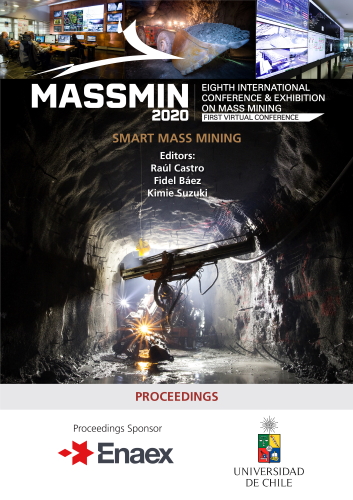Papomono mine modelled as an inclined cave

|
Authors: Villa, D; Baraqui, J; Maass, S |
This paper is hosted with the kind permission of Lulea University of Technology, International Conference & Exhibition on Mass Mining, 2024.
DOI https://doi.org/10.36487/ACG_repo/2063_08
Cite As:
Villa, D, Baraqui, J & Maass, S 2020, 'Papomono mine modelled as an inclined cave', in R Castro, F Báez & K Suzuki (eds), MassMin 2020: Proceedings of the Eighth International Conference & Exhibition on Mass Mining, University of Chile, Santiago, pp. 182-194, https://doi.org/10.36487/ACG_repo/2063_08
Abstract:
For a low-grade deposit with low rock mass quality, the inclined caving method is a feasible option, representing a low-cost, high-productivity and flexible alternative for a complexly shaped orebody. After performing a number of analyses of the trade-offs between block caving, sub-level caving, sub-level stoping, etc. at its Papomono mine, Minera Tres Valles (MTV) opted for inclined caving due to the orebody’s geometry and the geotechnical conditions (low rock quality). This method permits optimisation of the development effort, increasing production and reducing operating costs and dilution. This paper examines the inclined caving model created using PCBC software, describing the overall process used to estimate reserves and the production schedule, including the inputs used as mine sequence, drawpoint commissioning and production rate, etc. as related to an operation of this type.
References:
Carew, T, 1992, ‘Footwall drawpoint caving at Cassiar Mine’, Proceedings MassMin 92: Symposium Series, South Africa, pp. 295-301.
Diering, T, 2000, ‘PC-BC: A Block Cave Design and Draw Control System’, in G Chitombo (ed.), Proceedings of MassMin 2000, Australian Institute of Mining and Metallurgy, Melbourne, Australia, pp. 469-484.
Fuykschot, J & Loewen, S, 2016, ‘Inclined Caving Option for the DNK Mine, Kazakhstan’, in C Carr & G Chitombo (eds), Proceedings of MassMin 2016, Australia, pp. 669-681.
Hannweg, L, 2004,’Koffiefontein mine front cave – Case History’, Proceedings of MassMin 2004, Santiago, Chile, pp. 393-396.
Jakubec, J & Laubscher, D, 2012, ‘Incline Cave Mining – A Viable Alternative to Horizontal Layout’, Proceedings of MassMin 2012, Sudbury, Ontario, Canada.
Jakubec, J, 1992, ‘Support at Cassiar underground mine’, Proceedings of MassMin 1992, South Africa, pp. 111-123.
Laubscher, D & Jakubec, J, 2000, ‘Block Caving Manual – Incline Cave’, ICS 2000 internal document.
Laubscher, D, 1994, ‘Cave mining – the state of the art’, Journal of The South African Institute of Mining and Metallurgy, South Africa, pp. 279-293.
Minera Tres Valles, 2018, ‘NI 43-101 F1 Technical report mineral resource estimate.
Minera Tres Valles, 2018, Prefeasibility Study (C40012-TV-03-RPT-003).
Mthombeni, C & Paucar, M, 2004, ‘Incline cave: A technical alternative to mine kimberlite deposits at depth’, Proceedings of 5th International Conference & Exhibition on Mass Mining, Chile, pp. 91-95.
Valencia, J, Paredes, P & Macias, F, 2014, ‘La Encantada - An inclined cave design’, Proceedings of 3rd International Symposium on Block and Sublevel Caving, Chile, pp. 217-223.
Villa, D, 2016, ‘Remnant ore model generation and categorization post block-caving extraction at Salvador mine’, in C Carr & G Chitombo (eds), Proceedings of MassMin 2016, Australia, pp. 461-470.
Villa, D, 2014, ‘Mine sequence optimization for Block Caving using the concept of best and worst case’ Proceedings of 3rd International Symposium on Block and Sublevel Caving, Chile, pp. 426-436.
© Copyright 2025, Australian Centre for Geomechanics (ACG), The University of Western Australia. All rights reserved.
View copyright/legal information
Please direct any queries or error reports to repository-acg@uwa.edu.au
View copyright/legal information
Please direct any queries or error reports to repository-acg@uwa.edu.au
